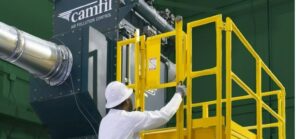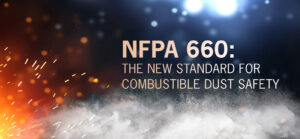Combustible dust collector explosions are a serious risk at most manufacturing, processing and metalworking plants. They can occur without warning in many areas, but one of the most common locations is the dust collection system. That’s because these systems hold a lot of suspended combustible dust in one confined space. An unprotected dust collection system has a high risk of explosions, which is why they are addressed by OSHA’s National Emphasis Program for combustible dust. An explosion in an unprotected dust collector produces a high pressure wave that can fragment the housing and send heat, flames, and dangerous projectiles into the workplace. This can critically injure personnel.
Passive vs. Active explosion protection
However, a properly designed dust collector that handles combustible dust always includes an explosion protection system. The goal of any type of explosion protection equipment is to control dust collector explosions, keep employees safe, and minimize damage. There are many different types of devices and systems, and they fall into two general categories: active and passive.
Active systems such as chemical isolation and fast acting valves react prior to or during a deflagration event. These systems involve costly technology and typically requires recertification every three months. Passive systems react immediately following an event to prevent the deflagration from traveling to other areas and causing more damage. They control the speed of explosions by releasing the pressure produced when they have reached a certain limit. Most manufacturers use passive systems because they are a lot less costly and don’t require continual recertification. Whichever system you install, make certain to use certified explosion protection devices.
Explosion venting
Explosion venting is the most commonly used passive system. It is designed to be the “weak” link of the dust collector. When the inside of the collector reaches a predetermined pressure, the explosion vent opens, allowing the excess pressure and flame front to exit to a safe area. It’s designed to safely vent the gases and pressures from a deflagration to minimize damage and injury to workers in the area. NFPA 68 standard sets the criteria for the design, location, installation, maintenance and use of these systems.
Flameless venting
Designed to be installed over a standard explosion vent, a flameless vent extinguishes the flame exiting the vented area, preventing it from exiting the device. With flameless venting, conventional venting can be placed indoors as long as there is a designated safe zone.
Explosion isolation
Isolation valves provide an additional layer of protection. These valves are installed in the inlet ducting to create a mechanical barrier that keeps explosion flame and pressure from traveling through ducts into the process area. Normal airflow keeps the valves open, but the pressure wave forces it closed in the event of an explosion. Flames and smoke are therefore contained.
Safety Monitoring Filter
An integrated safety monitoring filter is considered an outlet protection device because it protects the downstream equipment and work areas. Installed on the top of a dust collector, it acts as a flame front barrier. In the event of a dust collector explosion, the filter also prevents the flame front from entering the workspace because it contains the fuel – the explosive dust – in the collector. Camfil's integrated safety monitoring filter is an effective flame front arrestor for ST1 and ST2 dusts according to NFPA-mandated design options. These performance-based design options are provided in Chapter 5 of NFPA 654 and NFPA 69.
Additional explosion protection technologies
When planning explosion protection, don’t overlook additional devices and materials that can help reduce fire risk within the dust collection system. For spark-generating applications, a range of features and technologies are available, from flame retardant and carbon conductive filter media to spark arrestors in the form of drop-out boxes, perforated screens or cyclone device installed at the collector inlet. Fire sprinkler systems may also be required with some installations and can be coupled with smoke detection or other pressure detection systems.
 Americas
Americas 








